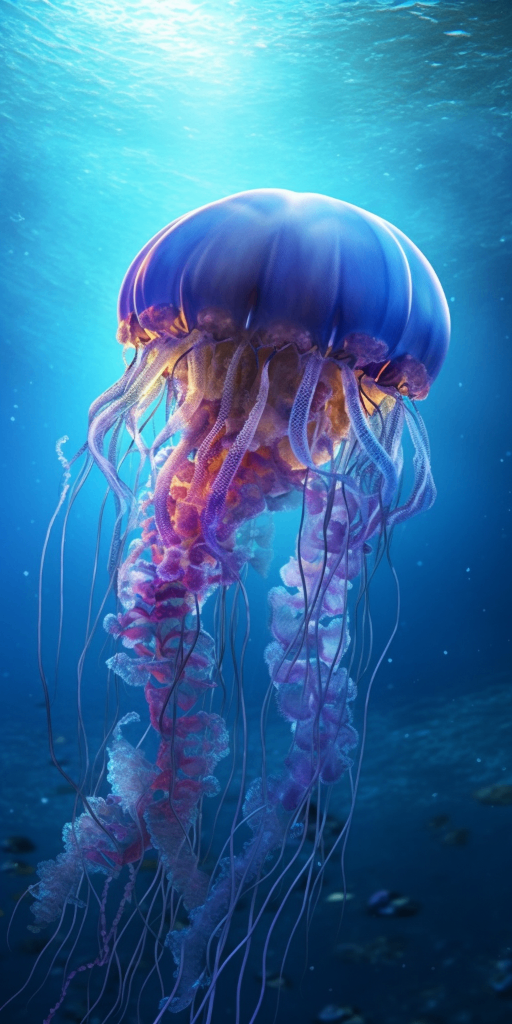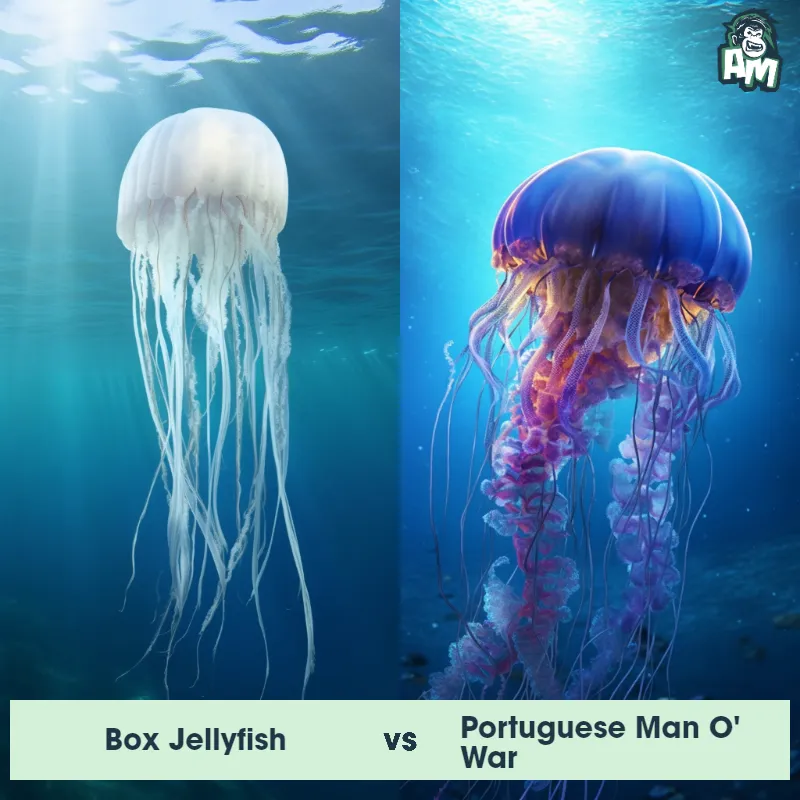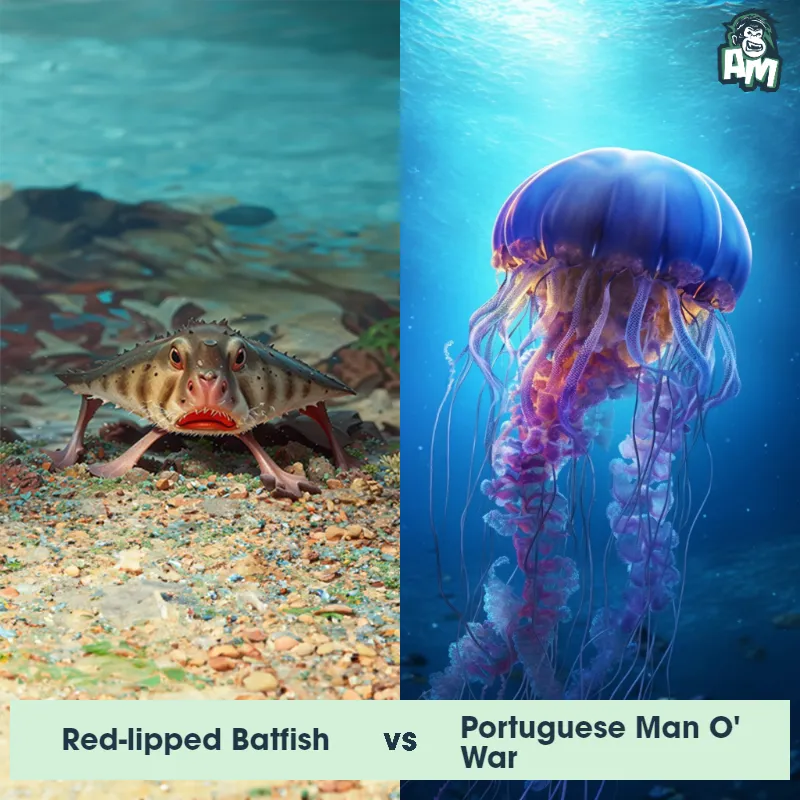The Portuguese Man O' War
The Portuguese Man O' War, also known as Physalia physalis, is not a single organism, but a colony of specialized marine animals working together. It consists of a gas-filled bladder that functions as a float and sail, and numerous long tentacles lined with stinging cells called nematocysts. The Man O' War can reach lengths of up to 30 meters, with the tentacles extending several meters below the surface. Its translucent float is usually blue or purple, while the tentacles are pinkish, providing a distinct and vibrant appearance. Despite its mesmerizing beauty, it is important to note that its stings are extremely painful and can cause severe reactions, including anaphylactic shock.

| Portuguese Man O' War | |
|---|---|
| Size | Up to 12 inches (30 cm) tall, tentacles up to 165 feet (50 m) long |
| Weight | N/A (floats on surface) |
| Speed | NA |
| Key Strength | Venomous tentacles |
| Biggest Weakness | Fragile body, easily damaged |
| Scientific Name | Physalia physalis |
| Family | Physaliidae |
| Habitat | Open ocean |
| Geography | Found in warm waters worldwide |
| Diet | Small fish and plankton |
| Lifespan | 1 day - 1 year |

The Portuguese Man O' War
The Portuguese Man O' War, also known as Physalia physalis, is not a single organism, but a colony of specialized marine animals working together. It consists of a gas-filled bladder that functions as a float and sail, and numerous long tentacles lined with stinging cells called nematocysts. The Man O' War can reach lengths of up to 30 meters, with the tentacles extending several meters below the surface. Its translucent float is usually blue or purple, while the tentacles are pinkish, providing a distinct and vibrant appearance. Despite its mesmerizing beauty, it is important to note that its stings are extremely painful and can cause severe reactions, including anaphylactic shock.
Fun Fact: The tentacles of the Portuguese Man O' War can extend up to 165 feet 50 meters in length, allowing it to capture prey such as small fish and even crustaceans from a significant distance away.
| Portuguese Man O' War | |
|---|---|
| Size | Up to 12 inches (30 cm) tall, tentacles up to 165 feet (50 m) long |
| Weight | N/A (floats on surface) |
| Speed | NA |
| Key Strength | Venomous tentacles |
| Biggest Weakness | Fragile body, easily damaged |
| Scientific Name | Physalia physalis |
| Family | Physaliidae |
| Habitat | Open ocean |
| Geography | Found in warm waters worldwide |
| Diet | Small fish and plankton |
| Lifespan | 1 day - 1 year |
Match Highlights
Portuguese Man O' War Matchups
We use AI to simulate matchups between the Portuguese Man O' War and other animals. Our simulation considers size, strength, and natural predatory behaviors to determine the most likely outcome.

Can't find the Matchup you want?
Create Your Own MatchupPortuguese Man O' War: Diet, Predators, Aggression, and Defensive Behaviors
What do Portuguese Man O' War eat?
Portuguese Man O' War are carnivorous organisms that primarily feed on small fish and plankton. They use their tentacles to paralyze and capture prey, injecting venom that helps break down the food before they ingest it.
Do Portuguese Man O' War have any predators?
Despite their venomous tentacles, Portuguese Man O' War have a few predators, including sea turtles, certain species of fish, and seabirds. Some specialized predators have developed immunity to their venom and are able to feed on them without any harm.
Are Portuguese Man O' War aggressive?
Portuguese Man O' War are not aggressive towards humans or other organisms. They float along the ocean's surface, relying on ocean currents and winds to move. However, if they come into contact with a potential threat, such as a predator or a swimmer, they can deliver a powerful sting as a defense mechanism.
Do Portuguese Man O' War fight with other organisms?
Portuguese Man O' War do not actively seek out confrontations with other organisms. They rely on their venomous tentacles to defend themselves in the event of a threat. However, if they come into contact with another organism that they perceive as a danger, they may use their tentacles to sting and deter the threat.
How do Portuguese Man O' War defend themselves?
Portuguese Man O' War defend themselves using their venomous tentacles, which can deliver a painful sting. The tentacles are covered in nematocysts, specialized stinging cells that release toxins upon contact. These toxins can cause severe pain, redness, swelling, and even allergic reactions in humans.
What is Portuguese Man O' War's biggest weakness in a fight?
Despite their potent venom and long tentacles, Portuguese Man O' War have a vulnerability to certain predators that have developed immunity to their toxins. Some species of fish, turtles, and seabirds have mechanisms that allow them to feed on Portuguese Man O' War without being harmed by their stings. This weakness puts them at risk of being preyed upon in the ocean ecosystem.
Fun Fact: Despite its resemblance to a jellyfish, the Portuguese Man O' War is not a jellyfish at all. It belongs to a group of animals called siphonophores, which are colonial organisms composed of specialized individuals known as zooids, each with a specific function.
Fun Fact: The Portuguese Man O' War has a unique and effective means of reproduction. It reproduces through internal fertilization, with the male releasing sperm into the water and the female capturing it with her tentacles. The fertilized eggs develop into larvae, which are then released into the water to grow into new colonies. Unlike most organisms, the Man O' War does not undergo separate male and female stages in its lifecycle.













